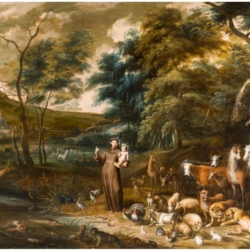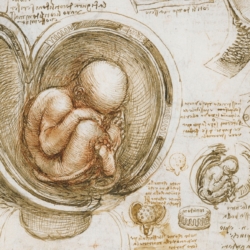| Source (Hebrew) | Translation (English) |
|---|---|
אֱלֹהֵי הָרוּחוֹת, נָתַתָּ בְּיָדֵינוּ הַכֹּחַ שֶׁלֹא־הָיָה כֵן כָּמֹהוּ מֵרֵאשִׁית הָרָת עוֹלָם לְהֲפוֹךְ סִדְרֵי בְּרֵאשִׁית. |
Elohei Haruḥot,[1] Numbers 27:16 God of all spirit, all directions, all winds, You have placed in our hands power unlike any since the world began to overturn the orders of creation. |
אַנָא הָאֵל תֵּן לָנוּ חָכְמָה וּתְּבוּנוֹת כַּפָּיִם לְרַפְּאוֹת אֶת־הַשָּׁמַיִם וְאֶת הָאָרֶץ מֵעוֹנוֹתֵינוּ, יְקוּם פּוּרְקָן לִשְׁמַיָּא כְּדֵי שֶׁיוּשְׁפַּע עַלֵינוּ בִּרְכָּת הַחַמָּה לְחַיִּים וְלֹא לְמָות, לִבְרָכָה וְלֹא לִקְלָלָה שֶׁנֶאֱמַר “אֶפְתַּח לָכֶם אֵת אֲרֻבּוֹת הַשָּׁמַיִם וַהֲרִיקֹתִי לָכֶם בְּרָכָה עַד־בְּלִי־דָי וְלֹא־יַשְׁחִת לָכֶם אֶת־פְּרִי הָאֲדָמָה.” |
Please God, give us wisdom and skillful hands[2] Psalms 78:72 to heal the Skies and the Earth from our sins; Y’kum purkan lish’maya[3] the traditional blessing for the congregation begins “y’kum purkan min shamaya“, may salvation arise from the Heavens. ‘May salvation arise for the heavens’ that the blessings of the sun flow over us for life and not for death, for blessing and not for curse, as it says, ‘I will open for you the expanses of the Heavens[4] ”expanses”, arubot, is used to describe the release of the flood waters in the Noah story; in Malakhi it’s meaning is reversed from destruction to abundance. and will empty out for you a blessing beyond what is enough and Earth’s fruit will not be destroyed[5] usually interpreted to mean “your produce will not be destroyed”, but new times reveal new meanings. because of you.’[6] Malakhi 3:10-11 |
אֵל מָלֵא רַחֲמִים, זְכוֹר לָנוּ בְּרִיתֶךָ עִם כָּל הַחַיִּים, בְּרִית מֵי נֹחַ, וּפְרוֹשׂ סֻכַּת רַחֲמִים וְשְׁלוֹם עַל כָּל מִינֵי הַחַיִּים וְעָלֵינוּ, הַקִּיף כֻּלָם יוּחַסֵינוּ בְּזִּיו הַשְׁכִינָה בְּנַחַל עֲדָנֶיך תָּשְׁקֵם בְּכָּל מוֹשְׁבוֹתֵיהֶם וְאַז נִרְאֲתָה הַקֶשֶׁת בֶּעָנָן שָׂשׂ וּמִתְפָּאֵר בַּגְוֹוָנִין, וְיָשׁוּב עֵץ הַחַיִּים לְאֵיתָנוֹ הָרִאשׁוֹן. |
God full of compassion, remember Your covenant with all life, the covenant of the waters of Noah. [7] the covenant was not made with humans first, but rather with the land and with all the creatures, Genesis 9:9-12 Spread a Sukkah of compassion and peace over us,[8] a refrain found many places, but especially in the Sefardi liturgy for Ushpizin, where it is echoed several times. over all Life’s species; Surround all our relations,[9] a Native American epithet meaning all species of life and all creatures, which as we know from Spirit and from science are truly our relations. with Shekhinah’s radiance;[10] what the righteous enjoy in the coming world, but also in the Sefardi Ushpizin something we pray for in the here and now. Water them with Your river of delights[11] Psalms 36:8 in all of their habitats. Then ‘the bow will appear in the cloud’,[12] v’nir’atah hkeshet be’anan, from Genesis 9:14, quoted by P’ri Eitz Hadar as a sign of the restoration of original blessing. (Note however that for much of Kabbalah, the rainbow has the opposite meaning, that God needed to be reminded, k’v’yakhol, not to destroy the Earth.) The grammatical form is past tense with the Biblical vav hahipukh, which makes it future tense. joyful and beautified[13] also from P’ri Eitz Hadar, its referent in the original context is ambiguous, syntactically fitting with the rainbow but grammatically (by gender) with “the whole”. Either way, it’s a good thing. with its colors, and the Tree of Life[14] in Kabbalah, the sefirot; in ecology and evolution, the process of unfolding and becoming which makes all living things our relations, a process whose diversity is overwhelming and wondrous. will return to its original strength,[15] a quote from P’ri Eitz Hadar, which reads “hakol the Whole will return to its original strength”. Tree of Life is another epithet for all the Sefirot, which “hakol” also stands for. This is one of the most deeply ecological sentiments I have ever encountered in any pre-modern text (i.e., before ecology was even a concept). |
וּתְּזַכֵּנוּ, אֲנַחְנוּ וְצֶאֱצָאֵינוּ, לֵישֵׁב יָמִים רַבִּים עַל הָאֲדָמָה כִּיְמֵי הַשָּׁמַיִם עַל הָאָרֶץ. |
so that we and our descendants may merit to live many days on Earth, like days of the Skies over the Land.[16] Deuteronomy 11:21, a more concrete translation of “like the days of the Heavens over the Earth”. |
בָּרוּךְ חֵי הָעוֹלָמִים |
Blessed be the Life of the worlds! |
וְהָיָ֣ה׀ בַּיּ֣וֹם הַה֗וּא אֶֽעֱנֶה֙ נְאֻם־יְהוָ֔ה אֶעֱנֶ֖ה אֶת־הַשָּׁמָ֑יִם וְהֵ֖ם יַעֲנ֥וּ אֶת־הָאָֽרֶץ׃ |
And on that day I will answer, swears YHVH, I will answer the Skies, and they will answer the Land. (Hosea 2:23). |
Rabbi Seidenberg’s Prayer for the Earth was first posted at neohasid.org, here. The prayer is based on the P’ri Ets Hadar, Birkat Hachodesh, Sefardi liturgy for Sukkot, and Malakhi 4, Genesis 9:14; Psalms 36, 78, 146; Deuteronomy 32:11, 11:12.
This prayer is focused on global climate disruption (aka “global warming”), healing the skies, and the original blessing of creation. The liturgy is closely based upon the sun-blessing liturgy we used April 8th 2009. It is partly based on the Sefardi liturgy for the Ushpizin on Sukkot, and on “P’ri Eitz Hadar” (The Fruit of the Majestic Tree) — the first ever Tu biShvat seder, included in the 17th century mystical work, Ḥemdat Yamim (ed. Rabeinu Yakov Ben Yom Tov Algazi).
It can be used after the Torah service every Shabbat, after the prayer for the government or the State of Israel. It could also be used many other times, for example, after the counting of the Omer, on Lag BaOmer, or on Rainbow Day.
Notes
| 1 | Numbers 27:16 |
|---|---|
| 2 | Psalms 78:72 |
| 3 | the traditional blessing for the congregation begins “y’kum purkan min shamaya“, may salvation arise from the Heavens. |
| 4 | ”expanses”, arubot, is used to describe the release of the flood waters in the Noah story; in Malakhi it’s meaning is reversed from destruction to abundance. |
| 5 | usually interpreted to mean “your produce will not be destroyed”, but new times reveal new meanings. |
| 6 | Malakhi 3:10-11 |
| 7 | the covenant was not made with humans first, but rather with the land and with all the creatures, Genesis 9:9-12 |
| 8 | a refrain found many places, but especially in the Sefardi liturgy for Ushpizin, where it is echoed several times. |
| 9 | a Native American epithet meaning all species of life and all creatures, which as we know from Spirit and from science are truly our relations. |
| 10 | what the righteous enjoy in the coming world, but also in the Sefardi Ushpizin something we pray for in the here and now. |
| 11 | Psalms 36:8 |
| 12 | v’nir’atah hkeshet be’anan, from Genesis 9:14, quoted by P’ri Eitz Hadar as a sign of the restoration of original blessing. (Note however that for much of Kabbalah, the rainbow has the opposite meaning, that God needed to be reminded, k’v’yakhol, not to destroy the Earth.) The grammatical form is past tense with the Biblical vav hahipukh, which makes it future tense. |
| 13 | also from P’ri Eitz Hadar, its referent in the original context is ambiguous, syntactically fitting with the rainbow but grammatically (by gender) with “the whole”. Either way, it’s a good thing. |
| 14 | in Kabbalah, the sefirot; in ecology and evolution, the process of unfolding and becoming which makes all living things our relations, a process whose diversity is overwhelming and wondrous. |
| 15 | a quote from P’ri Eitz Hadar, which reads “hakol the Whole will return to its original strength”. Tree of Life is another epithet for all the Sefirot, which “hakol” also stands for. This is one of the most deeply ecological sentiments I have ever encountered in any pre-modern text (i.e., before ecology was even a concept). |
| 16 | Deuteronomy 11:21, a more concrete translation of “like the days of the Heavens over the Earth”. |

“תפלה על פרי אדמה | A Prayer for the Earth, by Rabbi David Seidenberg (neohasid·org)” is shared through the Open Siddur Project with a Creative Commons Attribution-ShareAlike 4.0 International copyleft license.










This is powerful and beautiful. Thank you.